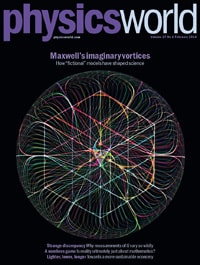
In this month’s cover feature, Margaret Morrison from the University of Toronto examines the use of “fictional models” in science, including Maxwell’s model of electromagnetism, which included a piece of pure fiction in the form of an invisible, all-pervasive “aether” made up of elastic vortices separated by electric charge.
On a more practical note, this month’s issue examines strange discrepancies in experimental measurements of the gravitational constant, G, while our lead news and analysis piece tries to find out more about the US National Security Administration’s leaked initiative on quantum computers. There’s an abridged extract of cosmologist Max Tegmark‘s new book about the mathematical nature of the universe and don’t miss a great Lateral Thoughts about an unusual domestic mystery – why tiny spikes grow in the ice tray in your freezer.
If you’re a member of the Institute of Physics (IOP), you can access the new issue with the digital edition of the magazine. If you’re not yet in the IOP, you can join now to get full access to Physics World as well as many other member benefits.
For the record, here’s a run-down of highlights in the issue.
• NSA keys into quantum computing – Leaked documents suggest that the US National Security Agency is developing quantum computers to crack cryptography codes, but what progress has the agency really made? Jon Cartwright investigates
• The spot in the shadow – Robert P Crease observes a simple demonstration that is at once a compelling educational tool and a dramatic lesson in science history
• Lighter, lower, longer – “Winning the race for growth” is what drives and motivates many politicians, but Peter Goodhew argues that physicists can contribute to the debate by arguing that bigger is not always better
• It’s all just mathematics – The world can be described using mathematical equations and numbers, but why does maths do it so well? In his new book Our Mathematical Universe, a section of which is abridged and edited in the new issue, Max Tegmark makes the radical proposal that our reality isn’t just described by mathematics – it is mathematics
• Fictional models in science – When James Clerk Maxwell set out his famous equations 150 years ago, his model of electromagnetism included a piece of pure fiction: an invisible, all-pervasive “aether” made up of elastic vortices separated by electric charges. Margaret Morrison explores how this and other “fictional” models shape science
• The lure of G – For over 200 years physicists have tried to pin down the value of the gravitational constant. Jon Cartwright finds out what’s been taking them so long
• From Euclid to Einstein – Patricia Fara reviews Magnificent Principia by Colin Pask
• Alices in a nuclear Wonderland – Kate Brown reviews The Girls of Atomic City by Denise Kierman
• A lasting legacy – Michael Conti-Ramsden describes how a physics degree and the Great Exhibition of 1851 helped turbocharge a career based on solving practical problems in chemical engineering
• Once a physicist – This month we talk to Dan Trueman, composer, Hardanger fiddle-player and a co-founder of the Princeton Laptop Orchestra
• Lateral Thoughts: When ice grows up – David Appell gets curious about spikes in his ice tray
Enjoy the issue – and let me know what you think by e-mailing me at pwld@iop.org.


